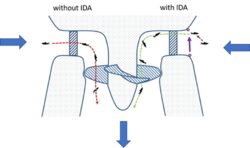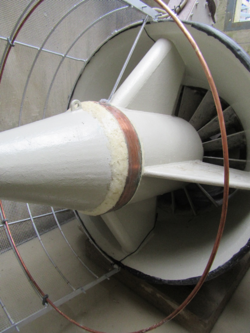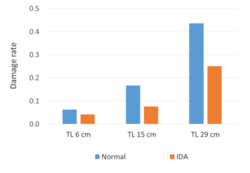Difference between revisions of "Fish Protection System (induced drift application)"
Bendikhansen (talk | contribs) |
Bendikhansen (talk | contribs) |
||
| (4 intermediate revisions by the same user not shown) | |||
| Line 1: | Line 1: | ||
| − | |||
{{Note|This technology has been enhanced in the FIThydro project! See [[Innovative technologies from FIThydro]] for a complete list.|reminder}} | {{Note|This technology has been enhanced in the FIThydro project! See [[Innovative technologies from FIThydro]] for a complete list.|reminder}} | ||
| − | |||
| + | =Quick summary= | ||
| + | [[file:IDA_fish_path.png|thumb|250px|Figure 1: Schematic sketch of fish passage through a vertical axis Kaplan turbine without (left) and with (right) IDA device.]] | ||
| + | [[file:IDA_pilot.png|thumb|250px|Figure 2: IDA pilot at the 35 kW Kaplan turbine intake at the TUM Lab with the two ring-shaped copper electrodes ]] | ||
| + | [[file:IDA_damage.png|thumb|250px|Figure 3: Comparison of observed damage rates for fish passage without (blue) and with IDA pilot device (red) for varying fish lengths (total length TL) in the 35 kW pilot.]] | ||
| − | = | + | Date: 2020 |
| + | |||
| + | Developed by: TU Munich, Chair of Hydraulic and Water Resources Engineering, Franz Geiger | ||
| + | |||
| + | Type: [[:Category:Devices|Device]] | ||
| + | |||
| + | =Introduction= | ||
| + | The IDA technology provides an alternative approach to improve fish downstream passage at HPPs. Fish damage rates during turbine passage are reduced by specific fish behavior manipulation prior and during passage using electric fields. The technique works without screening or bypass systems, no specific water losses occur or maintenance measures are required. Constructional efforts are very limited and therefore the IDA technology is well suited for retrofitting at existing HPPs. | ||
| + | |||
| + | =Application= | ||
| + | The exposure probabilities and intensities of blade strike and shear stresses to fish significantly depend on the actual location where fish enter and pass through the turbine. The technical implementation of the IDA device can be based generally on various behavioral stimuli like light, ultra-sound or electrical fields. Electrical fields are especially favorable due to the fish’s reaction on such. For low field strength, electric fields show repulsive effects on fish. For higher field strength, fish show automatic movement towards the anode (electro-taxis). Moreover, an electrically induced narcosis can occur and persist for a few seconds to a few minutes after field exposure (also called electro-narcosis) depending on the field strength and the exposure time. | ||
| + | |||
| + | For the simplest implementation, the IDA technology builds up a continuous electrical field and guides the fish to the anode, an entry point in the vicinity of the hub, where survival rates are high (see figure 1). Additionally, forcing fish prior to turbine passage into random orientation, e.g. by narcosis, can significantly further support survival of fish during turbine passage. During the FIThydro project a first pilot of the IDA has been tested at a small 35 kW Kaplan turbine in the TUM Lab in Obernach, Bavaria (see figure 2). | ||
| + | |||
| + | First results for the pilot operating in full load are presented in figure 3, showing a reduction of damage rates by about 55 %. The difference with and without IDA device is statistically relevant (Fisher´s exact test, p < 0.01). | ||
| + | |||
| + | =Relevant mitigation measures and test cases= | ||
| + | {{Suitable measures for Fish Protection System (induced drift application)}} | ||
| + | |||
| + | =Other information= | ||
| + | TUM holds an EU patent for the IDA (EP3029203). | ||
| + | |||
| + | =Relevant literature= | ||
| + | FIThydro deliverable D3.4 available at https://www.fithydro.eu/deliverables-tech/ | ||
[[category:Devices]][[Category:Enhanced in FIThydro]] | [[category:Devices]][[Category:Enhanced in FIThydro]] | ||
Latest revision as of 14:43, 9 October 2020
Contents
Quick summary
Date: 2020
Developed by: TU Munich, Chair of Hydraulic and Water Resources Engineering, Franz Geiger
Type: Device
Introduction
The IDA technology provides an alternative approach to improve fish downstream passage at HPPs. Fish damage rates during turbine passage are reduced by specific fish behavior manipulation prior and during passage using electric fields. The technique works without screening or bypass systems, no specific water losses occur or maintenance measures are required. Constructional efforts are very limited and therefore the IDA technology is well suited for retrofitting at existing HPPs.
Application
The exposure probabilities and intensities of blade strike and shear stresses to fish significantly depend on the actual location where fish enter and pass through the turbine. The technical implementation of the IDA device can be based generally on various behavioral stimuli like light, ultra-sound or electrical fields. Electrical fields are especially favorable due to the fish’s reaction on such. For low field strength, electric fields show repulsive effects on fish. For higher field strength, fish show automatic movement towards the anode (electro-taxis). Moreover, an electrically induced narcosis can occur and persist for a few seconds to a few minutes after field exposure (also called electro-narcosis) depending on the field strength and the exposure time.
For the simplest implementation, the IDA technology builds up a continuous electrical field and guides the fish to the anode, an entry point in the vicinity of the hub, where survival rates are high (see figure 1). Additionally, forcing fish prior to turbine passage into random orientation, e.g. by narcosis, can significantly further support survival of fish during turbine passage. During the FIThydro project a first pilot of the IDA has been tested at a small 35 kW Kaplan turbine in the TUM Lab in Obernach, Bavaria (see figure 2).
First results for the pilot operating in full load are presented in figure 3, showing a reduction of damage rates by about 55 %. The difference with and without IDA device is statistically relevant (Fisher´s exact test, p < 0.01).
Relevant mitigation measures and test cases
| Relevant measures | |
|---|---|
| Fish-friendly turbines | |
| Relevant test cases | Applied in test case? |
| Altheim test case | - |
| Altusried test case | - |
| Anundsjö test case | - |
| Bannwil test case | - |
| Bragado test case | - |
| Gotein test case | - |
| Guma and Vadocondes test cases | - |
| Günz test case | - |
| Ham test case | - |
| Las Rives test case | - |
| Schiffmühle test case | - |
| Trois Villes test case | - |
Other information
TUM holds an EU patent for the IDA (EP3029203).
Relevant literature
FIThydro deliverable D3.4 available at https://www.fithydro.eu/deliverables-tech/


